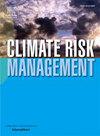Spatial risk assessment for climate proofing of economic activities: The case of Belluno Province (North-East Italy)
IF 4.8
2区 环境科学与生态学
Q1 ENVIRONMENTAL SCIENCES
引用次数: 0
Abstract
Recent advancements in spatial risk assessment methodologies, particularly those incorporating GIS and economic evaluations, have significantly enhanced our ability to assess and manage risks associated with natural disasters. Entrepreneurs, investors, and public administrations need information about climate change risks for effective planning and decision making. To move from generic global or national projections about climate change scenarios, towards more actionable information on climate risks for socioeconomic agents, the three dimensions of risk (Hazard, Exposure and Vulnerability) must be quantified and mapped with the involvement of stakeholders. In this study, spatial indicators, tailored to the social and ecological systems of interest and co-designed with the key stakeholders are aggregated into sectoral risk indexes quantified in economic terms. Climate risk indexes were calculated and mapped for the four key economic sectors of the study area of the Belluno Province (Italian Alps): summer tourism, winter sports and events, eyewear industry, and electricity supply. Stakeholders were involved during the assessment to share knowledge, data and needs and to provide expert judgments on intermediate and final results. Outputs include a series of maps and statistical summaries, highlighting future trends of climate related risks, their spatial variability within the area and the estimated levels of uncertainty. Estimates on expected changes of future damages with constant Exposure and Vulnerability, provided socioeconomic agents with simple and clear messages about how their activities could suffer or benefit from climate change in the future.
经济活动气候防护的空间风险评估:贝卢诺省(意大利东北部)案例
空间风险评估方法的最新进展,特别是结合地理信息系统和经济评估的方法,大大提高了我们评估和管理自然灾害相关风险的能力。企业家、投资者和公共管理部门需要有关气候变化风险的信息,以便进行有效的规划和决策。为了从一般的全球或国家气候变化情景预测转向为社会经济主体提供更具可操作性的气候风险信息,必须在利益相关者的参与下对风险的三个维度(危害、暴露和脆弱性)进行量化和绘图。在本研究中,根据相关社会和生态系统定制并与主要利益相关方共同设计的空间指标被汇总为以经济术语量化的部门风险指数。气候风险指数是针对贝卢诺省(意大利阿尔卑斯山)研究区域的四个主要经济部门计算和绘制的:夏季旅游业、冬季运动与活动、眼镜业和电力供应。在评估过程中,利益相关者参与其中,分享知识、数据和需求,并就中期和最终结果提供专家意见。成果包括一系列地图和统计摘要,突出了与气候相关风险的未来趋势、其在该地区内的空间可变性以及不确定性的估计水平。在 "暴露 "和 "脆弱性 "不变的情况下,对未来损害的预期变化进行估算,为社会经济行为主体提供简单明了的信息,说明他们的活动在未来可能如何受到气候变化的影响或从中受益。
本文章由计算机程序翻译,如有差异,请以英文原文为准。
求助全文
约1分钟内获得全文
求助全文
来源期刊

Climate Risk Management
Earth and Planetary Sciences-Atmospheric Science
CiteScore
8.20
自引率
4.50%
发文量
76
审稿时长
30 weeks
期刊介绍:
Climate Risk Management publishes original scientific contributions, state-of-the-art reviews and reports of practical experience on the use of knowledge and information regarding the consequences of climate variability and climate change in decision and policy making on climate change responses from the near- to long-term.
The concept of climate risk management refers to activities and methods that are used by individuals, organizations, and institutions to facilitate climate-resilient decision-making. Its objective is to promote sustainable development by maximizing the beneficial impacts of climate change responses and minimizing negative impacts across the full spectrum of geographies and sectors that are potentially affected by the changing climate.
 求助内容:
求助内容: 应助结果提醒方式:
应助结果提醒方式:


